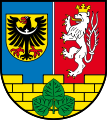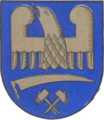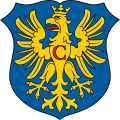Silesian eagle (heraldic animal)
As Silesian eagle in the be Heraldry The heraldic animals of Silesia designated. A distinction is made between two different representations for Lower Silesia and Upper Silesia .
Lower Silesian Eagle
The Lower Silesian eagle is black and is usually depicted with golden armor , a red knocked out tongue and a red beak on a golden shield . Its special distinguishing mark is the silver chest moon with a silver cross raised in the middle , which is shaped like a clover leaf . In some variants it is shown crowned .
The Lower Silesian eagle originally goes back to the coat of arms of the Polish princeps and at the same time the piastic Duke of Silesia, Henry II the Pious . Subsequently, other Dukes of Silesia wore this coat of arms. It was initially adopted for the Lower Silesian principalities and continues to be a symbol of Czech Silesia . In contrast, a different color scheme was used in Upper Silesia since the 14th century.
The partial crowning of the Lower Silesian eagle was used from 1817. In Prussian Silesia it was depicted in the form of a ducal crown from 1864 . From 1890 the elector's hat was put on the Lower Silesian eagle . After 1918, the crown was dropped.
Today, the Lower Silesian eagle, in addition to being used for the Polish Lower Silesian Voivodeship , can also be found as part of the national coat of arms of the Czech Republic , the coat of arms of the Moravian-Silesian country in the Czech Republic and the district of Görlitz in Germany , as well as in numerous city coats of arms of Germany, Poland and the Czech Republic.
Coat of arms of Duke Heinrich of Breslau in Codex Manesse from the 14th century
Coat of arms of the Silesian dukes of Brzeg around 1370
Coat of arms of the Silesian Dukes of Sagan around 1500
Coat of arms of the Prussian province of Silesia from 1815 to 1919
Coat of arms of the Prussian province of Silesia with male band from 1842
Coat of arms of the Prussian province of Silesia around 1880
Coat of arms of Lower Silesia in the Austro-Hungarian coat of arms by Hugo Ströhl from 1890
Coat of arms of the Duchy of Upper and Lower Silesia as the Crown Land of Austrian Silesia around 1890
Coat of arms of the Prussian province of Lower Silesia from 1918 to 1933
Coat of arms of Czech Silesia since 1918
The Silesian Probation Badge from 1919
Part of the coat of arms of the German Landsmannschaft Silesia since 1950
Coat of arms of the Polish Lower Silesian Voivodeship since 1999
Wroclaw's coat of arms shown since 1530
Coat of arms of the Czech Moravian-Silesian country since 2001
Coat of arms of the Czech Olomouc country since 2000
The national coat of arms of the Czech Republic in the depiction since 1993
Coat of arms of the German district of Görlitz since 2008
Nowa Sól coat of arms since the 14th century
Lubin coat of arms since 1996
Coat of arms of Liechtenstein since 1957
Upper Silesian Eagle
The Upper Silesian eagle is golden and is shown standing on a blue shield with golden reinforcement and rarely with a red tongue out. In some variants it is divided and depicted over a golden scythe leaf with the tip turned to the left and the edge turned downwards. There are also crossed golden hammers in the base of the shield and a golden crown of leaves, some of which are set with precious stones .
The Upper Silesian eagle probably goes back to the coat of arms of the Bohemian liege lord Wladislaus II of Opole and the Duchy of Opole formed in 1180 . The coat of arms has been traceable in its own coloring since the 14th century. The eagle has been shown crowned since the 15th century. The split version of the coat of arms with a scythe leaf was adopted in 1926 for the Prussian province of Upper Silesia . The scythe leaf depicted in it symbolizes the agriculture that is predominant in western Upper Silesia , the crossed hammers in turn symbolizes the mining industry that predominates in eastern Upper Silesia . The halved eagle is an allusion to the division of Upper Silesia in 1922 as a result of the uprisings in Upper Silesia .
Today, the Upper Silesian eagle, in addition to the uncrowned variant for the Polish Voivodeship of Silesia and the crowned variant for the Polish Voivodeship of Opole , is also part of the coat of arms of the Moravian-Silesian country in the Czech Republic and in numerous city coats of arms in Poland and the Czech Republic.
Coat of arms of Duke Wladislaus II of Opole from 1370 to 1395
Coat of arms of the Silesian dukes of Teschen from 1475 to 1500
Coat of arms of the Duchy of Teschen in the 19th century
Coat of arms of Upper Silesia in the Austro-Hungarian coat of arms by Hugo Ströhl from 1890
Coat of arms of the Prussian province of Upper Silesia 1919-1938, awarded in 1926, and Otto Hupp designed
Coat of arms of the Prussian province of Upper Silesia from 1941 to 1945
Part of the coat of arms of the German Landsmannschaft Silesia since 1950
Flag of the German Landsmannschaft der Oberschlesier from 1974
Coat of arms of the Polish Silesian Voivodeship from 1920 to 1939
Upper Silesian Star Order of the Republic of Poland from 1925
Order of the Upper Silesian Cross of the Republic of Poland from 1921
Coat of arms of Upper Silesia on the deed of union of the Silesian Voivodeship with the Republic of Poland from 1922
Coat of arms of the Polish Opole Voivodeship since 1950
Coat of arms of the Polish Silesian Voivodeship since 1999
Coat of arms of the Polish district of Cieszyn since 1999
Coat of arms of Opole since the 13th century
Gliwice coat of arms since 1596
Bytom coat of arms since 1886
Chorzów's coat of arms since 1938
Karviná coat of arms since 1993
Ruda Śląska's coat of arms since 1998
Coat of arms on a flag of the Movement for the Autonomy of Silesia from 2011
literature
- Maximilian Gritzner : Regional and heraldry of the Brandenburg-Prussian monarchy. History of their individual parts of the country, their rulers and coats of arms , Heymann-Verlag, Berlin 1894.













































